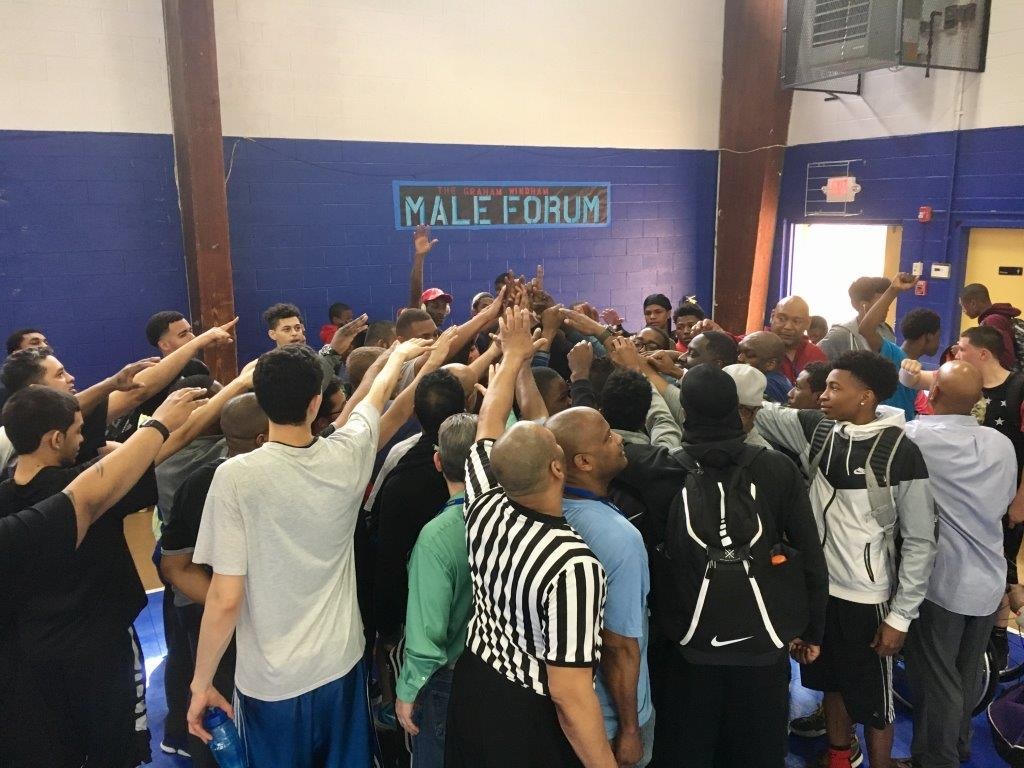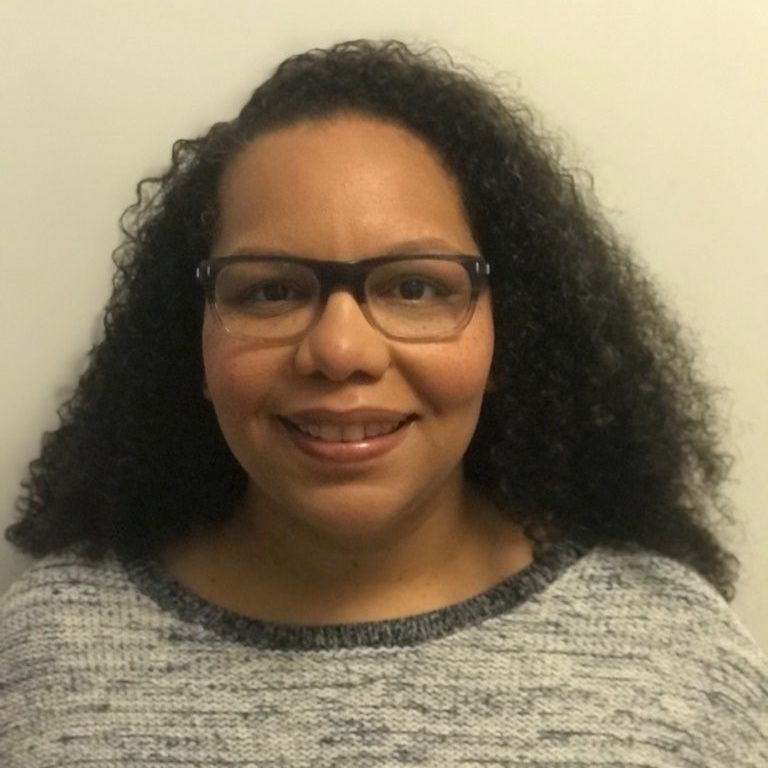
Harry Berberian
Graham SLAM develops community spirit by bringing staff and youth together through gatherings such as this basketball event.
Young people in the child welfare system, most of whom have experienced trauma and frequent loss, have all the same capabilities as children without such experiences, but face multiple obstacles to reaching their full potential. Often, they are more accustomed to transition than stability, and they lack a consistent, positive support system, making it difficult for them to envision and then stick to a productive pathway. Older youth who are still involved in the foster care system are also more likely to have lived in multiple homes and experienced a higher level of caseworker turnover.

Pilar Larancuent
As a result, it is not uncommon for these young people to become “agency- or service-adverse” and difficult to engage; some feel that the system has let them down and that the adults who they have been mandated to interact with do not truly care about them and/or will not be there for them in the long term. On top of this, public support for young people in foster care ends at age 21 (18 in some states), when few young people are ready to be on their own regardless of their life circumstances. Without long-term adult support, simple issues can more easily escalate to outcomes such as homelessness, incarceration and unemployment.
Graham Windham, a family and youth development organization in New York City, launched an innovative program in 2014 called Graham SLAM (Support, Lead, Achieve, and Model) to engage older youth. In planning the program model, the Graham team conducted research on effective existing models, both in New York City and nationally, and identified key elements that were evidence-based/informed or showed promise to incorporate into the program.
Retention results

Katie Napolitano
Each of these elements was discussed with young people at Graham to make sure what was being built would resonate with them. SLAM provides youth, ages 16-25, with long-term, comprehensive supports from high school through postsecondary success and onto a living-wage career path. A key component of the model is long-term coaching: A coach engages the young person, builds a trusting relationship and works with them to identify educational and vocational goals and create individualized plans that are specific, actionable and realistic. Coaches also provide social/emotional support, help youth prevent and navigate obstacles as they arise and connect them to peer support groups and internal and external programs that relate to their interests, needs and goals. Youth can continue to receive services until age 25.
SLAM’s model has proven to be very effective in engaging older youth, some of whom were previously service-adverse, and driving strong academic and post-secondary outcomes. Of the first SLAM cohort of 85 youth, 91 percent remained engaged for more than a year, and 53 percent were still being actively coached two to three years later. A Harvard Family Research Project and Public Private Ventures 2010 study on programs for older youth defined high retention as 50 percent or more of a program’s participants for 12 months or more.
Of the 148 youth who were actively coached over a two- to three-year period, 93 percent (137) achieved positive educational milestones and/or were employed. For the pivotal step of high school graduation, 88 percent of 21-year-olds participating in SLAM have graduated, compared with 67 percent of 21-year-olds who have aged out of foster care nationally. While an exact New York City comparison is not available, 22 percent of the 646 youth who aged out of care in 2017 over the age of 18 had a high school degree or equivalency. The majority (68 percent) of those New York City young people were 21.
Some of the key aspects of SLAM’s model and specific techniques that drive its high engagement rates include:
- Voluntary services and a “once SLAM, always SLAM” policy. Young people come to SLAM through various channels, but program participation is voluntary. Youth can decide whether and to what extent to engage, whether it be through long-term coaching or receiving targeted services (e.g., college admission assistance, tutoring, peer group services, etc.). Making services voluntary is empowering and allows the young person to be in control, which often results in greater willingness to engage. There are also no screening mechanisms or requirements to participate, and young people who decide to leave the program for any reason are welcomed back.
- Coaches are trained in evidence-supported engagement models. All coaches have experience with and a passion for working with adolescents and use a strength-based, positive youth development approach that focuses on what youth are able to achieve, not past behaviors. Coaches also receive training in motivational interviewing and solution-based casework, which allows them to meet young people “where they are” and set measurable goals based on their individual strengths, interests, needs and developmental stage.
- Consistency, consistency, consistency. Many young people in foster care have suffered from inconsistent and/or disrupted adult supports, which can make it challenging to form trusting, long-term relationships. Coaches make themselves available to youth 24/7 and practice consistency — if they say they are going to do something, they keep their word, and if they are unable to for some reason, they communicate why. They are there for the young person not only during critical transitions and crises, but to celebrate important life moments and achievements.
- Making communication comfortable. Coaches strive to not only meet young people on their level, they will also meet them wherever they feel most comfortable — at a McDonald’s, a local park or in the home. This facilitates a more casual conversation and allows the young person to open up and begin the process of building trust. Coaches use whatever form of communication that particular young person is most comfortable with, including texting and various forms of social media.
- Persistence. For youth who are particularly hard to engage, coaches continue to reach out and leave them messages that they should reach out any time, about any matter. Some youth take time to trust that the adult is truly interested in their well-being, and they will seek assistance once they know the intentions are coming from a genuine, caring place.
- Creating a familiar, communal culture. At Graham, staff make a purposeful effort to be warm and engaging with every individual who walks through the doors, and the SLAM program helps foster a sense of community. This is particularly important for young people who may have developed a heightened sensitivity to any environment where they are not met with a welcoming air. It also helps with longer-term engagement; should a coach leave Graham, it is likely that that young person feels comfortable continuing to engage with the other staff and has built a network of support at Graham.
Helping the gladiators
Once engaged, the frequency and level of interaction vary based on the youths’ needs and their movement through different phases, including “intensive,” “supportive,” “stability” and “launching.” The earlier stages often coincide with more frequent, in-person meetings, and lessen as the young person gains more skills, experience and stability. That said, coaches are mindful that a young person can slip from a stable, successful place into crisis, and they will adjust the level of support as needed. The young people served by the SLAM program have come to rely on the stability of the coaches and team and look to them for guidance as they navigate their transition into adulthood and a living-wage career path.
When a young person is difficult to engage, the SLAM staff are consistent and patient. Last year, the SLAM team was struggling to stabilize and engage a 20-year-old in services. This young person would refuse to leave the foster home and lock himself in the home playing video games all day. The foster parent requested that he not be in her home when she was not home. Therefore, he would stay in the office all day using the computers. He was becoming disruptive at the site and staff was unsure about how best to support him.
It was a turning point when this young person barricaded himself in one of the offices at our site and the police had to be called to escort him from the premises. His SLAM coach and case planner worked together in “One Graham” fashion to create a plan to help this young person succeed based on an understanding of what he was trying to achieve — safety and security — and break old habits.
Their goal for this young person was to stabilize him and get him back on track to meet his educational and vocational goals. In one year, with intensive guidance and support from his SLAM coach and case planner, this young man successfully participated in summer employment and is enrolled in college. These positive changes are testaments to all the great things our young people can accomplish when the right support systems are in place.
Foster youth are gladiators; they have endured more trauma and instability than most adults will in their entire lifetime. When they receive consistent, long-term support from caring adults who can help them navigate obstacles and connect them to resources and opportunities, they can achieve anything they put their mind to.
Pilar Larancuent is the director of the Graham SLAM program at Graham Windham in New York City.
Katie Napolitano is a consultant for the Graham SLAM program at Graham Windham in New York City.






























